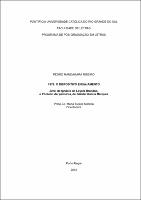| Share record |


|
Please use this identifier to cite or link to this item:
https://tede2.pucrs.br/tede2/handle/tede/2053Full metadata record
| DC Field | Value | Language |
|---|---|---|
| dc.creator | Ribeiro, Pedro Mandagará | - |
| dc.creator.Lattes | http://buscatextual.cnpq.br/buscatextual/visualizacv.do?id=K4594020Y0 | por |
| dc.contributor.advisor1 | Moreira, Maria Eunice | - |
| dc.contributor.advisor1Lattes | http://buscatextual.cnpq.br/buscatextual/visualizacv.do?id=K4783059Y6 | por |
| dc.date.accessioned | 2015-04-14T13:38:39Z | - |
| dc.date.available | 2012-05-10 | - |
| dc.date.issued | 2012-03-27 | - |
| dc.identifier.uri | http://tede2.pucrs.br/tede2/handle/tede/2053 | - |
| dc.description.resumo | Esta tese se inscreve dentro do projeto contemporâneo de escrever a história da literatura de um só ano, no caso o ano de 1975. Para tanto, toma-se o conceito de dispositivo, de Michel Foucault, e seus desenvolvimentos por Hans Ulrich Gumbrecht e Giorgio Agamben, e se descreve o dispositivo engajamento. O dispositivo é descrito de maneira genealógica, a partir de leituras de Jean-Paul Sartre e Theodor Adorno. É mostrado que o conceito de engajamento apresenta três acepções, descritas como três níveis. A seguir se analisam os romances Zero, de Ignácio de Loyola Brandão, e El otoño del patriarca, de Gabriel García Márquez, ambos publicados em 1975, no que se refere aos seus narradores e protagonistas, e se comparam os resultados da análise aos níveis do engajamento descritos anteriormente. Conclui-se que há a presença do dispositivo engajamento nas obras analisadas. Nas considerações finais, discute-se a inscrição histórica dos romances, tanto na história geral da América Latina quanto em relação à história literária e cultural | por |
| dc.description.abstract | This dissertation is part of a contemporary trend of writing the literary history of a single year in this case, 1975. To do that, I take Michel Foucault s concept of apparatus, and its development by Hans Ulrich Gumbrecht and Giorgio Agamben, and describe the apparatus of engagement. The apparatus is described genealogically, through readings of Jean-Paul Sartre and Theodor Adorno. I show that the concept of engagement has three different meanings, which I describe as three levels. The novels Zero, by Ignácio de Loyola Brandão, and El otoño del patriarca, by Gabriel García Márquez, both published in 1975, are analyzed in what pertains to their narrators and protagonists, and the results are compared to the described levels of engagement. The conclusion shows that there is a presence of the apparatus of engagement in these novels. In the concluding remarks, the historical inscription of the novels is discussed, both relating to Latin American general history and to cultural and literary history | eng |
| dc.description.provenance | Made available in DSpace on 2015-04-14T13:38:39Z (GMT). No. of bitstreams: 1 438274.pdf: 749191 bytes, checksum: 5a86611e2ffd30a2441da10e580daa6a (MD5) Previous issue date: 2012-03-27 | eng |
| dc.format | application/pdf | por |
| dc.thumbnail.url | http://tede2.pucrs.br:80/tede2/retrieve/9395/438274.pdf.jpg | * |
| dc.language | por | por |
| dc.publisher | Pontifícia Universidade Católica do Rio Grande do Sul | por |
| dc.publisher.department | Faculdade de Letras | por |
| dc.publisher.country | BR | por |
| dc.publisher.initials | PUCRS | por |
| dc.publisher.program | Programa de Pós-Graduação em Letras | por |
| dc.rights | Acesso Aberto | por |
| dc.subject | LITERATURA - HISTÓRIA | por |
| dc.subject | ROMANCES - HISTÓRIA E CRÍTICA | por |
| dc.subject.cnpq | CNPQ::LINGUISTICA, LETRAS E ARTES::LETRAS | por |
| dc.title | 1975 : o dispositivo engajamento : Zero, de Ignácio de Loyola Brandão, e El otoño del patriarca, de Gabriel García Márquez | por |
| dc.type | Tese | por |
| Appears in Collections: | Programa de Pós-Graduação em Letras | |
Files in This Item:
| File | Description | Size | Format | |
|---|---|---|---|---|
| 438274.pdf | Texto Completo | 731.63 kB | Adobe PDF |  Download/Open Preview |
Items in DSpace are protected by copyright, with all rights reserved, unless otherwise indicated.




